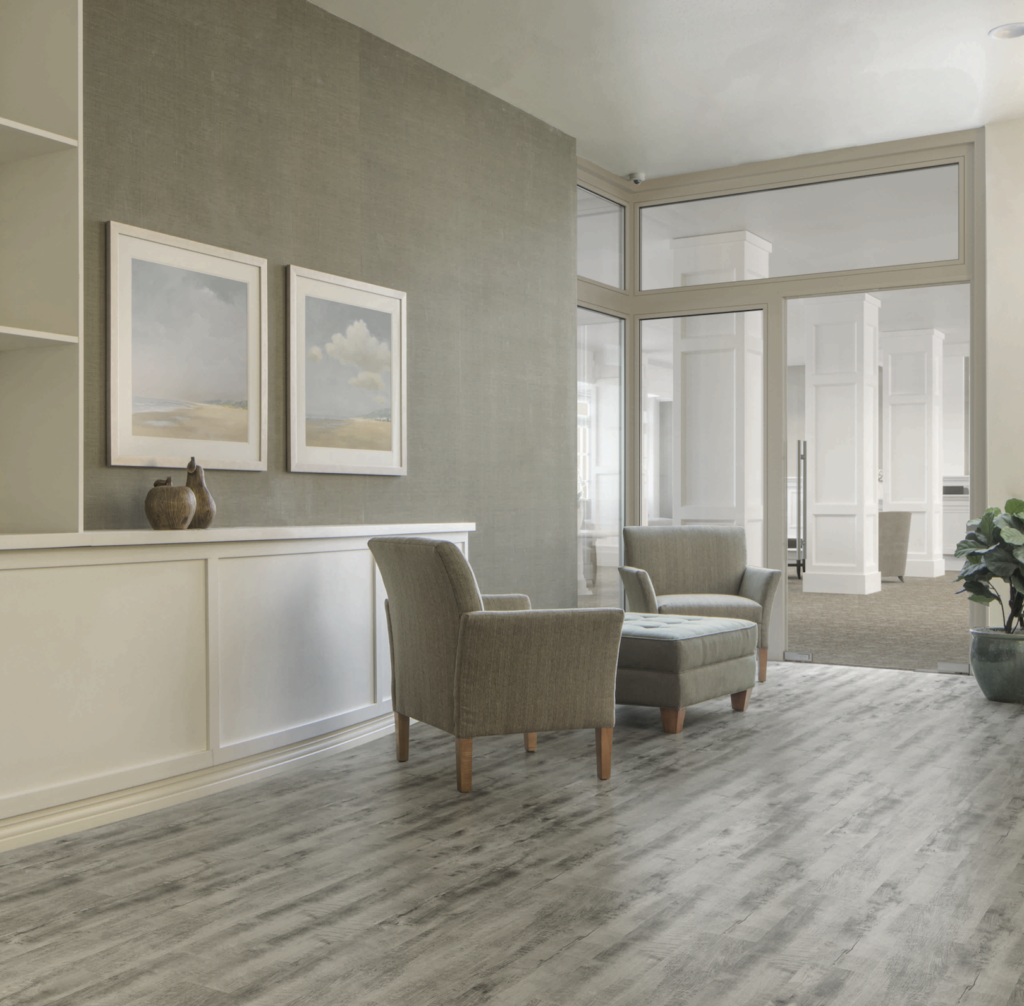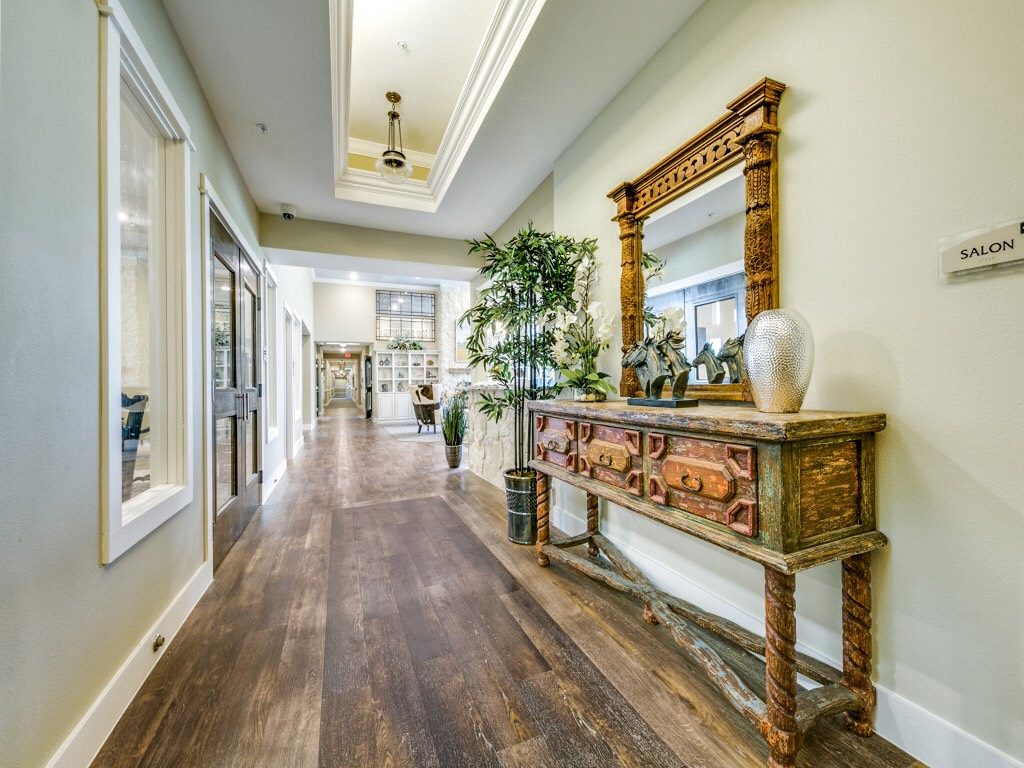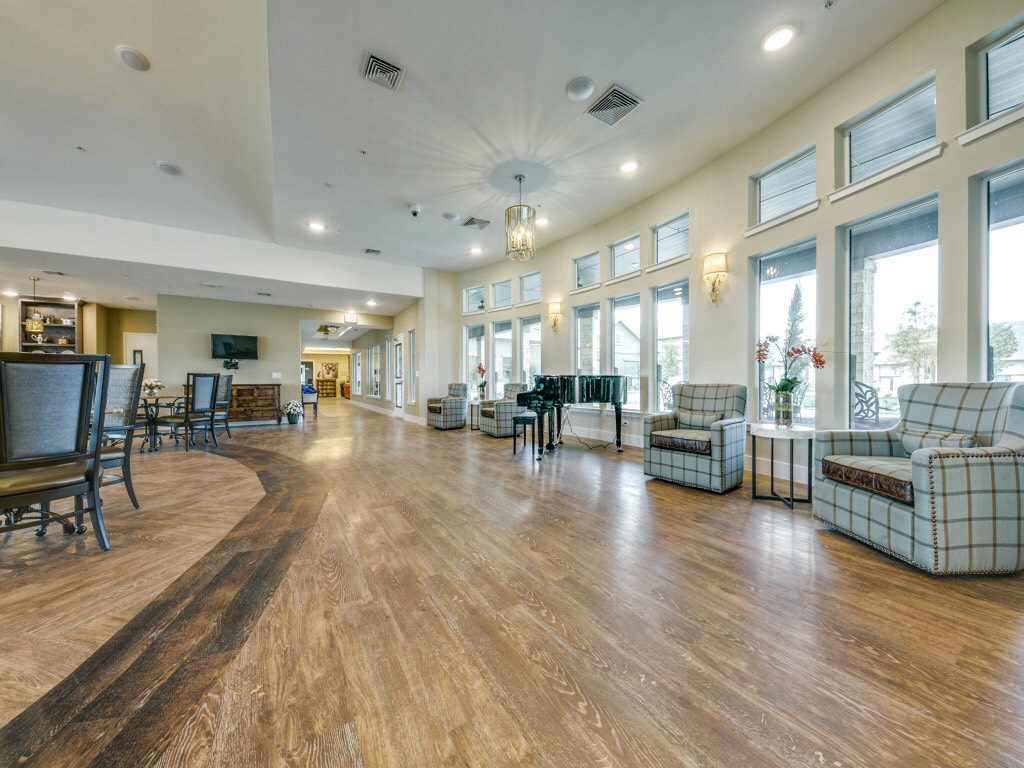
Mannington Commercial’s Select Wood in barnwood gunpowder
comes in a variety of specs and is constructed with micro-beveled edges.
Assisted living facilities curate a residential feel
“Creating a home-like environment can put residents at ease and contributes to a calming, healing environment.”
— larry browder, chief sales/marketing officer, Karndean Designflooring
As the U.S. population continues to age — the U.S. Census Bureau recently reported that by 2035 there will be 78 million people 65 years and older compared to 76.7 million under age 18 — assisted living facilities across the country are undergoing extensive redesigns in an effort to meet the needs of the next generation of residents.
However, unlike generations past, healthcare designers and flooring vendors alike have noted a shift from an “institutional” look within these spaces toward a more homey, residential feel — a new design focus that has the potential to better support patient outcomes.
“We’ve certainly seen more of the ‘resi-mercial’ trend — the incorporation of residential design into commercial spaces — when it comes to assisted living facilities,” said Larry Browder, chief sales/marketing officer, Karndean Designflooring. “Creating a home-like environment can put residents at ease and contributes to a calming, healing environment.”
Within those applications, flooring has become an integral component, capable of bringing the entirety of a design together. April Hoelscher, senior marketing manager, commercial channel, Armstrong Flooring, noted one of the major trends in this design is providing access to nature and the use of natural elements to help promote healing. “This concept extends from healing gardens and expansive views to material finishes that mimic natural wood and stone,” she said.
She’s not the only one. Kieren Corcoran, Patcraft’s director of performance markets, also noted a popularity among nature-inspired product choices. “In memory care or areas with seniors who have cognitive disorders, while colors that are applicable to moods and rhythms — low contrast and limited-use yellow hues — are common, we are seeing larger organic/nature-inspired patterns with cool and warm neutrals remain popular,” he said.
Color can also play a role in creating a home-like feel. “The use of warm colors, across both wood and stone visuals, allows for the creation of an inviting, comforting environment,” Browder said.
Jean Hansen, senior professional associate and sustainable interiors manager at HDR Architecture in San Francisco, echoed those sentiments, adding that color can play many roles within these designs, including bringing outside elements in. “Color plays a role in so many ways, including the overall aesthetic, speaking to the environment the facility is in, the overall design details, wayfinding and graphics,” she said. “Providing color in the interior can help replace the colors that can be enjoyed in the greater world for those who are unable to get outside as much, any longer, or at all.”

Karndean Designflooring’s Van Gogh collection features a variety of wood looks.
In terms of specific materials, Patcraft’s Corcoran said one of the most common flooring choices for senior living communities is broadloom, which can provide a warm, hospitality-like aesthetic. “Broadloom with a moisture barrier is a popular choice for the memory care areas of these communities,” he said. “Patcraft provides a low-profile, level loop carpet for roller mobility, broadloom with performance backing for moisture resistance and 5mm LVT with hospitality-inspired visuals that are the same thickness as carpet tile to minimize transitions strips.”
Lilliana Alvarado, design principal of Uphealing in Bedford, N.H., agreed, all flooring transitions should be the same height without the use of transition strips to avoid any tripping hazards. “My preferred flooring types for these facilities are carpet, rubber and vinyl flooring,” she said. “I recently had an installation with carpet tiles and loose lay LVT that were the same height. The entire installation was seamless and allows for a small part of the flooring to be replaced if needed. These types of facilities deal with patients with incontinence issues, and replacing the flooring when needed helps.”
As for hard surface, Corcoran said the company is also seeing a broad use of natural-looking wood visuals and those that have low color contrast between pieces and are highly coordinated with carpet choices.
Al Boulogne, vice president, commercial resilient business, Mannington, said resilient flooring, including sheet, planks and tiles, continues to gain traction because of its overall performance story combined with limitless design capabilities. He also noted the importance of aligning a design aesthetic across multiple flooring types to create a truly cohesive living space.
“By taking designs across multiple categories, we are able to offer coordinating patterns in carpet, sheet, LVT, rubber, etc.,” he said. “So, if the product is appropriate for the design intent of the space, the designer can find that styling thread throughout our portfolio. That way, the environment isn’t disrupted because a product has to be selected for a certain functional purpose within the facility. Instead, the LVT in the corridors can coordinate with the carpet in the common areas and the rubber in the therapy rooms.”
FINDING OUR WAY TO BETTER OUTCOMES
While material design plays an integral role in the success of these commercial spaces, designers agreed safety remains a top propriety. However, safety and design are not mutually exclusive, and some designers noted several ways in which the two can combine to improve the overall outcome of a space — and those who reside inside it.
Wayfinding, for example, is an important part of healthcare safety design as it not only allows visitors to find their way but can help keep residents from getting lost. When implemented correctly, designers said, wayfinding can reduce stress levels for patients, visitors and staff.
“Resilient flooring designs can help to delineate specific areas and guide visitors along the right path,” Armstrong’s Hoelscher said. “This allows staff to spend less time providing directions and more time caring for patients.”
She added that rolls of homogeneous and heterogeneous sheet product can provide endless corridors and walkways with safe, level pathways without bumpy transition strips that can handle shuffling walkers to heavy rolling loads without adding excess resistance.
Color choices are also integral to a successful wayfinding strategy. For example, Karndean’s Browder explained that darker shades can be used as drop-off colors or used to create barriers. “Many facilities will choose to change the aesthetic in different parts of the facility or on different floors so that it’s easier to recognize which area you’re in,” he added. “Having flooring options that are compatible yet also allow you to switch looks makes this much easier.”

Karndean Designflooring’s Hessian Oak in burnished cypress
was used to zone a majority of the dining area.
Eco-conscious choices
When it comes to senior living, manufacturers are also answering the call for eco-conscious design, a factor especially important in healthcare. However, vendors noted sustainability has evolved in recent years and so, too, must design.
“A decade ago sustainability was about single attributes — recycled content, rapidly renewable materials — primarily driven by LEED. Today, sustainability has grown-up,” Armstrong’s Hoelscher said. “It is more than just adding recycled content or rapidly renewable materials. It is about transparency, life cycle thinking and making an overall better product from a holistic perspective. With this growth in sustainability has come the realization that design can impact health and wellness.”
HDR Architecture’s Hansen said she asks manufacturers to be transparent and provide HPDs (health product declarations) and EPDs (environmental product declarations). “We want to make sure the manufacturers are committed to transparency as this can lead to optimization of products over time,” she said. “All products have to meet the most stringent indoor air quality requirements as applicable to their product type. Whether the project is pursuing LEED, WELL or another third-party certification, supporting health is optimal to our practice.”
And while the priority put on sustainable products may vary greatly from community to community, manufacturers agreed they strive to provide products that contribute to LEED certification. “Patcraft offers many products that contribute to LEED certification through material health, which considers the chemical ingredients of every material in a product, down to 100 parts per million,” Corcoran said. “This means every ingredient representing at least 0.01% of the product is evaluated against 24 risk factors for human and environmental health. Most of our products are certified at the Silver level or above.”
Uphealing’s Alvarado noted when it comes to healthcare design, she always looks for materials that are sustainable, whether it needs to meet LEED requirements or not. “For me, being able to specify a product that will not affect the indoor air quality for people with an already compromised immune system is what matters.”
To see this story in print:
